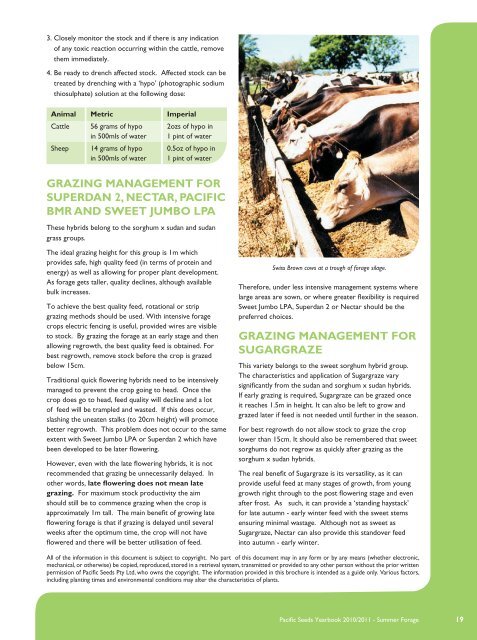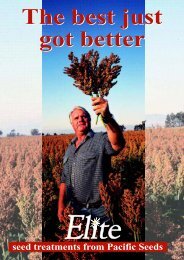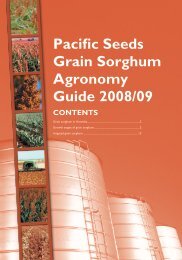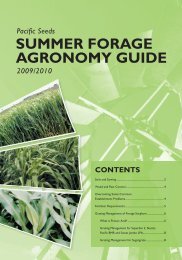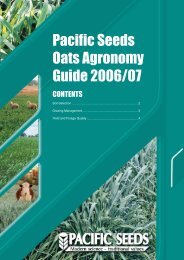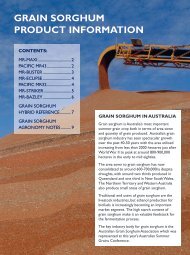SUMMER FORAGE pROdUct inFORMAtiOn - Directrouter.com
SUMMER FORAGE pROdUct inFORMAtiOn - Directrouter.com
SUMMER FORAGE pROdUct inFORMAtiOn - Directrouter.com
- No tags were found...
You also want an ePaper? Increase the reach of your titles
YUMPU automatically turns print PDFs into web optimized ePapers that Google loves.
3. Closely monitor the stock and if there is any indication<br />
of any toxic reaction occurring within the cattle, remove<br />
them immediately.<br />
4. Be ready to drench affected stock. Affected stock can be<br />
treated by drenching with a ‘hypo’ (photographic sodium<br />
thiosulphate) solution at the following dose:<br />
Animal Metric imperial<br />
Cattle 56 grams of hypo 2ozs of hypo in<br />
in 500mls of water 1 pint of water<br />
Sheep 14 grams of hypo 0.5oz of hypo in<br />
in 500mls of water 1 pint of water<br />
Grazing management for<br />
Superdan 2, Nectar, Pacific<br />
BMR and Sweet Jumbo LPA<br />
These hybrids belong to the sorghum x sudan and sudan<br />
grass groups.<br />
The ideal grazing height for this group is 1m which<br />
provides safe, high quality feed (in terms of protein and<br />
energy) as well as allowing for proper plant development.<br />
As forage gets taller, quality declines, although available<br />
bulk increases.<br />
To achieve the best quality feed, rotational or strip<br />
grazing methods should be used. With intensive forage<br />
crops electric fencing is useful, provided wires are visible<br />
to stock. By grazing the forage at an early stage and then<br />
allowing regrowth, the best quality feed is obtained. For<br />
best regrowth, remove stock before the crop is grazed<br />
below 15cm.<br />
Traditional quick flowering hybrids need to be intensively<br />
managed to prevent the crop going to head. Once the<br />
crop does go to head, feed quality will decline and a lot<br />
of feed will be trampled and wasted. If this does occur,<br />
slashing the uneaten stalks (to 20cm height) will promote<br />
better regrowth. This problem does not occur to the same<br />
extent with Sweet Jumbo LPA or Superdan 2 which have<br />
been developed to be later flowering.<br />
However, even with the late flowering hybrids, it is not<br />
re<strong>com</strong>mended that grazing be unnecessarily delayed. In<br />
other words, late flowering does not mean late<br />
grazing. For maximum stock productivity the aim<br />
should still be to <strong>com</strong>mence grazing when the crop is<br />
approximately 1m tall. The main benefit of growing late<br />
flowering forage is that if grazing is delayed until several<br />
weeks after the optimum time, the crop will not have<br />
flowered and there will be better utilisation of feed.<br />
Swiss Brown cows at a trough of forage silage.<br />
Therefore, under less intensive management systems where<br />
large areas are sown, or where greater flexibility is required<br />
Sweet Jumbo LPA, Superdan 2 or Nectar should be the<br />
preferred choices.<br />
Grazing management for<br />
Sugargraze<br />
This variety belongs to the sweet sorghum hybrid group.<br />
The characteristics and application of Sugargraze vary<br />
significantly from the sudan and sorghum x sudan hybrids.<br />
If early grazing is required, Sugargraze can be grazed once<br />
it reaches 1.5m in height. It can also be left to grow and<br />
grazed later if feed is not needed until further in the season.<br />
For best regrowth do not allow stock to graze the crop<br />
lower than 15cm. It should also be remembered that sweet<br />
sorghums do not regrow as quickly after grazing as the<br />
sorghum x sudan hybrids.<br />
The real benefit of Sugargraze is its versatility, as it can<br />
provide useful feed at many stages of growth, from young<br />
growth right through to the post flowering stage and even<br />
after frost. As such, it can provide a ‘standing haystack’<br />
for late autumn - early winter feed with the sweet stems<br />
ensuring minimal wastage. Although not as sweet as<br />
Sugargraze, Nectar can also provide this standover feed<br />
into autumn - early winter.<br />
All of the information in this document is subject to copyright. No part of this document may in any form or by any means (whether electronic,<br />
mechanical, or otherwise) be copied, reproduced, stored in a retrieval system, transmitted or provided to any other person without the prior written<br />
permission of Pacific Seeds Pty Ltd, who owns the copyright. The information provided in this brochure is intended as a guide only. Various factors,<br />
including planting times and environmental conditions may alter the characteristics of plants.<br />
Pacific Seeds Yearbook 2010/2011 - Summer Forage 19


